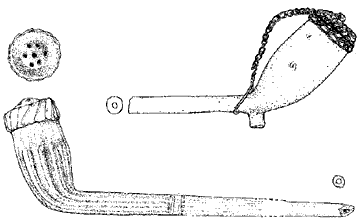|
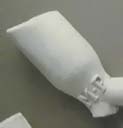
Pipe with heel, double-cone bowl, showing the Cologne
maker's initials MP, around 1680/90
|
No. 7/1995, p. 2-20
Ruud Stam: Pipes made by a pipemaker "M.P." found in
Cologne
Cologne is one of the oldest pipemaking centres in Germany, although
so far we only know this from documentary evidence. In 1989, Cologne
Museum purchased a collection of about 200 clay-pipe bowls and stems
which the owner said he found all together in a small bread oven.
This statement is supported by the fact that many of the pipes have
been fired at too high a temperature and thus may all belong to one
single firing. The pipe bowls are of double conical and funnel-shaped
types and can be dated at around 1680. The different ornamentations
permit the pipes to be subdivided into ten groups. None of the pipes
bear a mark, but pipes belonging to groups II, IV and IX bear the
initials "M.P." on the pipe bowl. So far it has not been
possible to assign the pipes to any of the known Cologne pipemakers.
The pipes have rather a low quality of finish, although they are closely
comparable in design to the typical pipes made internationally around
1680.
Altogether 24 different models of pipes can be recognised. These would
have required the same number of pipe moulds, suggesting a relatively
large pipemaker's workshop. The author estimates that fourteen people
were employed by the pipemaker "M.P."
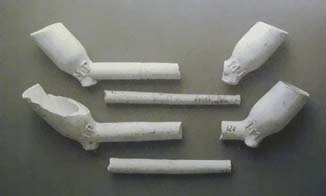
Clay pipes made by the Cologne pipe maker "MP"
around 1680/90

|
|
No. 7/1995, p. 20 f.
Rüdiger Articus: An old record of a clay-pipe find
A contemporary archaeological report on items found during the building
of a new theatre in Wismar in 1841 mentions several clay pipes.
The somewhat meagre description of the pipes, which bear the mark
"EB", and comparison of the description with similar finds
from other towns in northern Germany permit them to be dated as
just before 1700.

No. 7/1995, p. 22-28
Magret Karras: Westerwald products amongst clay-pipe fragments
found at Ahaus
Most of the clay-pipe fragments found during the last 20 years at
Ahaus are from the Netherlands. However, a few originate in the
Westerwald, Germany. Five of these bear the words "PETER/DORNI".
These, like another pipe fragment marked "IOHANNES/KEISER",
belong to the last third of the 18th century. Another pipe, probably
about the same age, is marked "K" and may have been made
by the Dorn brothers of Grenzhausen.
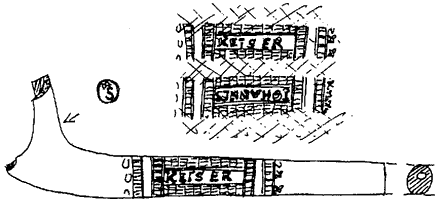
Heelless pipe made by Johannes Keiser, Höhr,
last third of 18th century
A pipe marked "ISER" with a crown (above) and a star
(below) is older, i.e. from the first half of the 18th century.
Another pipe marked with "K" and a Gouda coat-of-arms
(on the side of the spur) is probably from the 19th century. These
pipes are closely comparable to those found by M. Kügler in
the pipe-making towns of Höhr and Grenzhausen, and help to
document the distribution of Westerwald clay pipes.

|
|
|
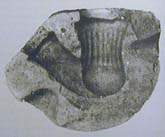
Fired clay mould for a stub-stemmed pipe with a ribbedbowl, Lesum,
N. Germany, second half of 18th century
|
No. 7/1995, p. 29 ff.
Horst Gnettner: Clay-pipe production at Lesum
A pottery and faience factory belonging to Johann Christoph Vielstich
existed in Lesum near Bremen in the then Electorate of Hannover
from 1758 until 1800. In 1982 during building work on the site of
Vielstich's factory, two halves of two pipe-bowl moulds made of
clay were found, but no clay-pipe fragments. It is possible that
these moulds were not used for actually producing clay pipes but
for making the plaster moulds in which the pipe bowls were made.
During this period a similar technique was used in porcelain manufacture.

|
|
No. 7/1995, p. 31 ff.
Rüdiger Articus: A so far unknown clay-pipe factory at Marne
in the district of Dithmarschen
The clay-pipe factory at Marne existed only a very short time. It
was founded early in 1813 by the businessman and spice trader Otto
Friedrich Frers, but was taken over in the summer of 1814 by one
of his employees. This man, whose name is not known, moved the factory
in the same year to Itzehoe; thus clay pipes were only produced
at Marne for about a year. No examples of the products of the Marne
factory have been found. Historical documents provide evidence of
Itzehoe's first pipe factory being established in 1814 by a certain
Johann Göbel. The author suggests that this was the nameless
person mentioned above.

No. 7/1995, p. 33-38
Olaf Rennebeck: "So much tobacco smoke that one can hardly
see three paces."
The author reports from a description of rural life published in
1858 that, in the so-called "Marsch" villages between
the Elbe and Weser estuaries, it was a tradition at family get-togethers
to provide tobacco and clay pipes for the guests. This is corroborated
by two invoices, one dated 1784 and the other about 1810. They list
goods supplied by tradesmen for two weddings; both include a large
quantity of tobacco, and the older invoice also lists clay pipes.

|
|
No. 7/1995, p. 38-44
Rüdiger Articus: "How careless smoking of tobacco could
be combatted."
In the 17th and 18th centuries, many sovereigns tried to combat
the danger of fire posed by lighted tobacco pipes by imposing severe
penalties - even death - for the careless use of pipes.
One law was enacted by the Duke of Braunschweig-Lüneburg
in 1719 making it compulsory for pipes to have a so-called
"Kapsel", a cap or lid made of metal or wire, while
being smoked. These caps or lids are also mentioned and figured
in other contemporary sources (edicts and technological literature)
and have been found in archaeological excavations in northern
Germany.
Clay pipes with and without heel fitted with
caps
made from 'knitted' brass wire and tin,
respectively; probably German, end of 18th century
|
|
|

|
|
|
No. 7/1995, p. 44-49
Walter Morgenroth: Clay pipes from East Friesland for Hannover
smokers in the Biedermeier period (early 19th century)
In 1816 Conrad Bernhard Meyer and a businessman named G. Kannegiesser
founded a clay-pipe factory in Aurich. It is reported that two years
later (1818) forty people were employed there and produced 12,000
gross (1,728,000) pipes per year; in 1824 about 75 people worked
in the factory. Pipes found in Aurich that can be shown to have
been made in Meyer's factory display an egg-shaped bowl typical
of that period. Some of the marks have so far not been recorded;
it is inferred that, since most of the pipes were sold in the Netherlands,
Gouda marks were the most frequently used. However, in spite of
official market-protection measures (less tax on locally made pipes),
the factory could not hold out against persistent competition and
had to close in 1839.

|

zoom
|
No. 7/1995, p. 50-63
Ekkehard Reiff: Clay-pipe finds in the Harz Mountains. A preliminary
report
The author describes a small selection of the many pipes that have
been found in the seven towns of the Oberharz (the upper part of
the Harz Mountains), which have been mining towns for centuries.
The clay pipes range in age from the last third of the 17th century
to the beginning of the 20th century. Many of them are imports from
the Netherlands; one of these bears a portrait of William IV of
Orange (the "Statthalter" of the Netherlands from 1747-1751)
and his wife. Some of the pipes which bear inscriptions honouring
the Duke of Brunswick-Lüneburg were possibly made in the Westerwald,
Uslar, or Holzminden. Other pipes with motives relating to mining
and bearing the name "KNECHT", either as a mark or on
the stem, were probably made in a German town. Pipemakers with this
name are recorded from Grossalmerode between 1729 and 1855.
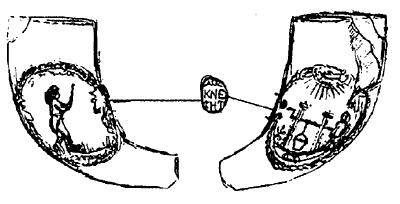
Heelless pipe showing a man with divining rod
on one side of bowl and a miner and winch (for metal ore) on
the other; pipe maker Knecht in Grossalmerode (?), second half
of 18th century
|
Finally, the author explains that the continuous drop in popularity
of clay-pipe smoking in the 19th century is reflected in the finds.
Tobacco was grown at that time on the western and northwestern sides
of the Harz Mountains and was smoked by the inhabitants of the Oberharz
mining towns predominantly in porcelain pipes or as cigarettes or
cigars.

|
|
No. 7/1995, p. 63 f.
Rüdiger Articus: Clay pipes from an early 17th century wreck
In 1994, the wreck of a 17th century ship was found buried in the
dike just west of Uelvesbüll in North Friesland. Currently
the wreck is undergoing conservation at Husum. Among the items found
in the wreck were four clay pipes. One of them was in a wooden pipe-case
bearing a monogram, the owner's mark, and the inscription "Ao
16..".

|
|
No. 7/1995, p. 65-69
Martin Kügler: Report on the 8th meeting of the German Society
for Clay-Pipe Research held in Mannheim on 30 April and 1 May 1994
The Society was invited by the Archaeological Collections Section
of the Reiss Museum, Mannheim, to hold its 8th annual meeting there.
Altogether 26 participants attended. I. Jensen, F. Teutsch, L. Huber,
H. Maier, H. G. Rein and K. Sarri gave papers on clay-pipe making
documented in the region around Mannheim, Heidelberg, and Frankenthal,
where it began in 1650. A special exhibition called "Smoking
and snuff-taking in the Palatine Electorate and elsewhere"
put together by I. Jensen and K. W. Beinhauer showed a large range
of products from the region. Other papers dealt with the following
topics: The development of the shape of clay-pipe bowls (W. Morgenroth),
the Schum wooden-pipe factory in Bad König (W. Stolle), and
the organisation of the clay-pipe makers in Westerwald during the
3rd Reich (R. Stam). Excursions visited the Erkenbert Museum in
Frankenthal, the Tobacco Museum in Hockenheim and a tobacco grower
in Mannheim-Seckenheim.
|
|







